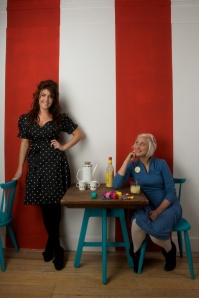 Last night’s Inspiring Entrepreneurs featured successful inventors and was organised in conjunction with our wonderful Inventing the 21st Century exhibition.
Last night’s Inspiring Entrepreneurs featured successful inventors and was organised in conjunction with our wonderful Inventing the 21st Century exhibition.
Our five speakers gave us their very different stories, but with common themes and lessons learnt.
 Natalie Ellis, inventor of the Road Refresher non-spill dog travel bowl.
Natalie Ellis, inventor of the Road Refresher non-spill dog travel bowl.
Natalie Tried for many years to get into the pet market. She came to The British Library about eight years ago and immersed herself in our market research reports and pet related industry information. This gave her the knowledge to understand the market and be able to sell effectively to supermarkets like Sainsbury’s.
This is a message I repeat to all of my clients in advice sessions. If your background is not from the sector you plan to launch your product or service, you must first gain in-depth industry knowledge by reading relevant publications, and even gaining some work experience where possible.
The idea for Road Refresher came from nearly being arrested by the police, for trying to let her dog drink water while driving her car. Natalie built a very basic prototype in her kitchen in the evenings while waiting for her daughter’s dinner to cook. As is almost always the case, her initial prototype didn’t work.
She displayed her final product at a trade show and generated interest there. This encouraged her to enter a women’s invention awards competition, where she won three awards, which led to BBC news coverage. Next came the fateful invite to appear on Dragons Den. Apparently the unusual chairs the Dragons sit in, make them look small and insignificant, which inspired (misplaced) confidence in Natalie. As anyone who has seen the clip will know, the experience turned out to be awful, with personal attacks from the Dragons due to Natalie’s lack of knowledge of the size of her market.
James Caan’s reaction to her plan to take the bowl to America, was to warn Natalie that America was the graveyard of British business. All successful inventors and entrepreneurs have ‘bounce back ability’, and so a few days later when she had stopped crying, and realised she believed in her product, she decided to ignore the Dragon’s advice.
She flew to America and took a stand at a trade show, and had initial difficulties selling the product, but by the time the Dragons Den show appeared on television, it had become the fastest selling dog bowl in America on Amazon.com.
Q&A
Q. Did anyone offer to licence the product?
A. She was offered a 3% licence and turned it down. The moulds are made in China, but by a company recommended by a personal contact.
Q. How to present your product to potential buyers?
A. Natalie demonstrates her product by waving a full bowl in front of potential buyers faces, and watches their reaction when no water spills onto them.
Mike Spindle, inventor of the revolutionary Trekinetic Wheelchair
Mike has a Formula 1 racing car background, but despite a lack of knowledge of the wheelchair sector or disability background he developed all aspects of the Trekinetic. He said the key is noticing the problem, and the poor current solutions in the market to address it. He thinks his lack of industry knowledge and decision not to review existing solutions or patents helped him find a truly innovative solution.
The initial trigger was seeing a trendily dressed young man stuck in a terribly old fashioned wheelchair, painted purple in a failed attempt to jazz it up.
Mike’s advice was first check existing solutions in the market place. Then sketchyou’re your solution, and build at prototype or test concepts using Meccano. Concentrate on function first, looks come second. Ultimately the product must sell itself. A big marketing budget will only take a mediocre product so far.
Don’t spend a fortune on prototypes, you can do a lot with MDF. Try and keep what you are doing as private and secret as possible.
Ask yourself if anyone will buy it. Mike gave the example of collapsible paper basket invention. Ingenious, but not ultimately not that useful.
Can you patent your idea? Use non disclosure agreements (NDA’s) to test out invention. They found a set of wheelchair users and gave them a questionnaire to fill out.
Beware of patent agents as their time is so expensive, and they want to write your application straight away, before searching the databases to see if you qualify.
You only have one chance to get it right, so make use of help from Business & IP Centre and the UK IPO.
If you believe in your idea, don’t give up – make it happen.
Mike’s crunch point was when he discovered the chair wouldn’t run in a straight line. It took a year to fix, but is now the best on the market and can be used one handed wheelchair occupants.
The wheelchair took six years of his life, but was worth it, and now the demand is greater than they can produce.
The key is to find customers that love your product and competitors who can’t copy it.

Michael Pritchard, inventor of the Lifesaver bottle
Michael started off by agreeing with the Natalie and Mike that it does feel very lonely at times when you are inventing.
He told us the story by the Lifesaver, which came about because he got angry during Boxing Day 2005 watching images of the Tsunami on television. People were dying due to a lack of clean water, so he decided to do something about it. But as is so often the way, work and life took over, and he didn’t pursue the idea. Then came hurricane Katrina, and the same problems again with lack of drinking water. He was appalled that it took five days to get water to the thousands of people stranded in the Superdome in New Orleans.
Needed a solution that did not require chemicals or power.
Michael then gave a very polished demonstration of the Lifesaver bottle, using very murky and smelly water from the bottom of his pond.
He talked passionately about his recent visit to Pakistan and used his own photos to show the extent of the flooding and its impact on the people there.
He said how great it felt to realise that giving them a Lifesaver jerry can took the place of a dependency on a regular supply of bottled water.
His motivation was a vision of his gravestone with nothing written on it. Also his wife told him to go for it.
Q. You on the stage tonight are the lucky ones.
A. Michael disagreed, the invention must meet and unmet need, but must also be commercial.
 Jim Shaikh, the inventor of Yoomi, self heating baby bottle
Jim Shaikh, the inventor of Yoomi, self heating baby bottle
Jim was the father of a three and half month weight premature baby. Jim’s job was to feed the baby at night, but kept getting the temperature wrong. Ended up with crying baby and crying wife upstairs.
It took a year to develop the concept, a bit like a combi-boiler and a gel-pack hand warmer, re-packaged into the top of a baby feeding bottle.
It has taken six years from original idea to get into Boots and soon into Europe.
Marketing tag line ‘Inspired by Mum, Designed by Dad’.
Wants to build a brand as it is more valuable than individual products.
Jim learnt about IP in the Business & IP Centre, and raised £140,000 from Angel investors. He made the very important point that a patent is an asset that helps convince investors of value of product.
It took a year to get funding for the product.
Prototyping is expensive. Jim used it to prove to investors that his product was a worthwhile investment. Took 3-4 prototypes to get the product right.
You need a support network to help you out.
You will hit low points, but part of being an entrepreneur is being able to deal with problems.
You need to be aware that competitors will respond, in Jim’s case with price cuts. How will you respond back? Do you have the flexibility?
 Mark Sheahan, the Business & IP Centre’s Inventor in Residence
Mark Sheahan, the Business & IP Centre’s Inventor in Residence
Mark used his immense experience of inventing and advising inventors to come up with a list of Do’s and Don’ts of inventing:
Keep your idea secret
Has to be better and or cheaper than the rest of the market
Have a professional patent search done
Review the prior-art, and carry on searching
Do your market research – players, size, prices
Is the market I am going into worth the time money and effort
Can you make the invention, and for the right price?
Look at how you can add value with your product
What is your USP? Why kill one rat when you can kill a hundred?
Helps to be optimistic
WIT – Whatever It Takes
Your enthusiasm will become infectious
Has to become the most important thing in your life
You need to become good at business
Understand the role of IP and patents
Secrets have a role to play
Don’t write your own patent – it is a false economy
Avoid sharks – not just the rogue Patent Promotion Agents
Listen to your gut feelings when dealing with people
Take on a business mentor with a couple of percentage of your business.
Create a SWAT analysis
Choose the right business model – draw up a partnership agreement
Don’t expect money from banks or government grants.
Make yourself investable – develop your marketing line
Understand contracts and letter writing
Get good at negotiating
Be realistic about the time scales – 15 years in the case of Dyson
Experience is rewarding even if you fail
Have fun with it
Questions
Q. When should one extend a British patent to a wider market?
A. Jim S – A difficult question as it is expensive to go wider. Need to think about where your market will be. Babies are born across the world. Strategy was to nationalise their patents in their biggest markets (USA and Europe).
Michael P – Find out where your competitors are manufacturing and patent there.
Q. How can you use a patent as collateral?
A. Jim S – I put in my patent into the business in exchange for investors money.
Q. Why not licence your product?
A. Mark S – I prefer to licence my technologies.
A. Michael P – Increase the value, decrease the risk by outsourcing the manufacture, but keeping control of selling and marketing of product as it is so new in the market. Wanted to build the value first.
Q. How did you foster partnerships and collaboration to get your invention market?
A. Natalie E – all self done
A. Jim S – used friends and family as focus groups, but using NDA’ and CDA’s. Balance between protecting what you have but getting valuable feedback from potential customers.
Q. The difference between being an inventor and an entrepreneur.
A. Natalie E – work to your strengths – go to trade shows to find the right
A. Mark S – licensing is a quicker and cheaper route
A. Michael P – get product into market as early as possible – don’t show a picture, have a prototype
A. Mike S – if you are going to licence your invention, make sure you get a serious amount of money up front to ensure they are committed.





















 Today seems to be the day for checklists. First there was
Today seems to be the day for checklists. First there was 


